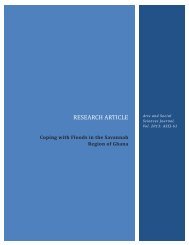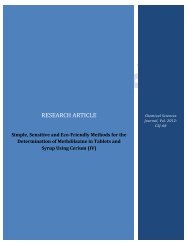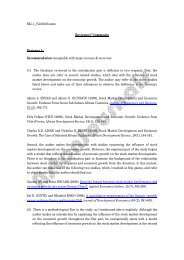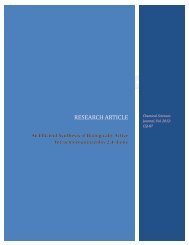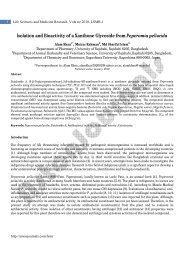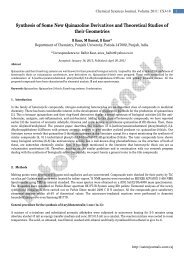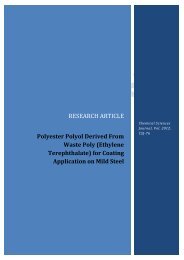RESEARCH ARTICLE - AstonJournals
RESEARCH ARTICLE - AstonJournals
RESEARCH ARTICLE - AstonJournals
- No tags were found...
Create successful ePaper yourself
Turn your PDF publications into a flip-book with our unique Google optimized e-Paper software.
6 Research ArticleFigure 4: The effect of NaCl on the Gibbs Free energy of Ba(OH) 2in different % compositionof ethanol at 10 6 18C.∆G (KJ/mole)3.2. Effect of mixed solvent systemThe values of DG8, DS8 and DH8 in presence of mixed solvent system (H 2O 1 1,2-propanediol or H 2O 1 ethanol)both in the presence and in the absence of NaCl are also collectively shown in Table 3. It was found that incase of Ba(OH) 2in (H 2O 1 1,2-propanediol, in the absence of NaCl), showed different behaviour comparedto that shown in above (water 1 NaCl) system where the increase in % composition of 1,2-propanediolwere generally increased values of DG8 and DS8. However, the values of DH8 were found to be nonlinear(due to the determination of DG8 in a small difference in temperature taken at 10 and 308C). In case ofBa(OH) 2in (H 2O 1 ethanol) only DG8 showed similar trend compared to 1,2-propanediol system. HoweverDS8 and DH8 values were found to be nonlinear (due to the determination of DG8 in small difference intemperature).3.3. Effect of ionic salt 1 mixed solvent systemIn case of Ba(OH) 2in (H 2O 1 1,2-propanediol 1 NaCl) system the same pattern was found i.e., only DG8 valueswere increased linearly by increasing % composition of 1,2-propanediol. Whereas, both DS8 and DH8 were linearlydecreased even at such low difference of temperature. Similarly Ba(OH) 2in (H 2O 1 ethanol 1 NaCl) system thevalues of DG8, DS8 and DH8 were generally increased by increasing % composition of ethanol.<strong>AstonJournals</strong>3.4. Qualitative characteristicsIn the experiment the initial conductance (in absence of titrant HCl) increased by increasing the amount of NaClwhere as the initial conductance decreased by increasing % of solvent (1,2-propanediol or ethanol) at 108C,which is shown in Figures 5 and 6. The same result was obtained for 308C. This trend is also justified by thedielectric constant values of water, 1,2-propanediol and ethanol which are 80.0, 30.2 and 24.6, respectively whichare given in Table 4. These dielectric constant values suggest that the influence of ionic salt (NaCl) enhances theconductance in high dielectric medium compared to solvent having low dielectric medium (hence offering lessconductance values).http://astonjournals.com/csjCo-Publisher: OMICS Group, www.omicsonline.org


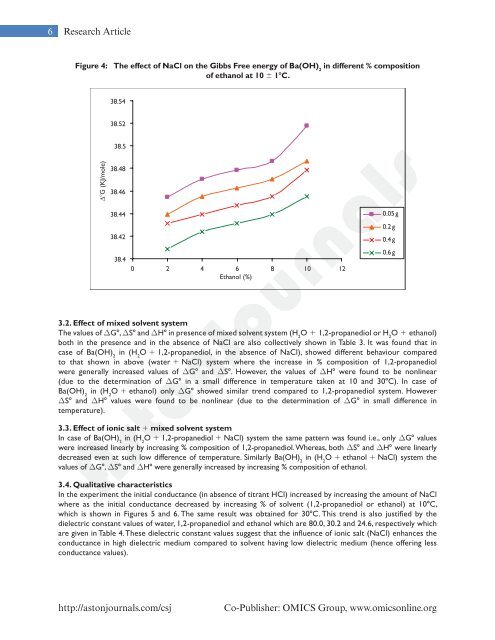
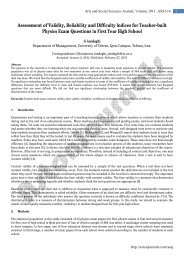
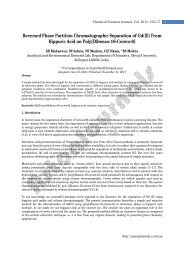
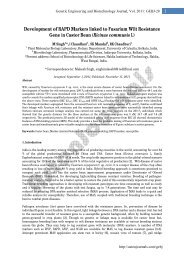

![[1,4]-benzodiazepine-2-one Derivatives as Potent - AstonJournals](https://img.yumpu.com/49117784/1/184x260/14-benzodiazepine-2-one-derivatives-as-potent-astonjournals.jpg?quality=85)
